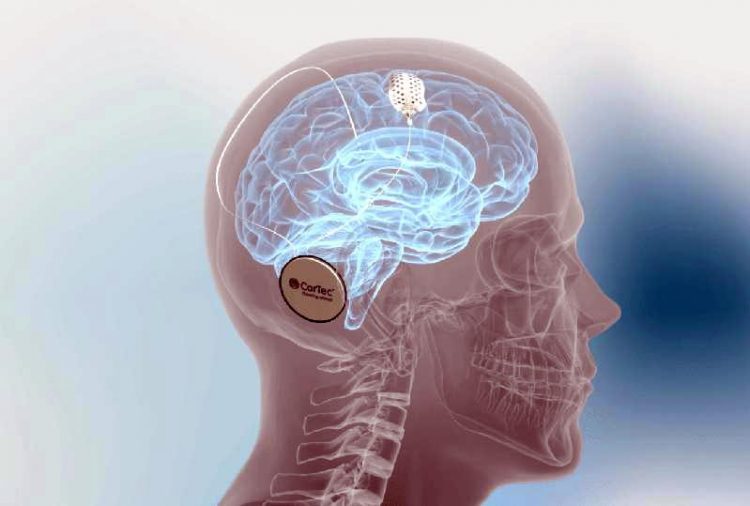2 million euros in funding for new MR-compatible electrophysiological brain implants

CorTec Brain Interchange, an implantable technology, can measure and stimulate brain activity for long-term use. CorTec Brain Interchange/CorTec GmbH
Professor Klaus Scheffler, physicist at the University of Tübingen, Germany, received funding for innovative science from the Federal Ministry of Education and Research (BMBF) to make neuro-implants suitable for everyday use, in particular to improve compatibility with medical diagnostic procedures such as MRI.
Scheffler works at the Max Planck Institute for Biological Cybernetics and the Werner Reichardt Center for Integrative Neurosciences at the University. The funded project is a joint venture between the University of Ulm, MPI for Biological Cybernetics, eesy-ic GmbH and the coordinator CorTec GmbH. The Federal Ministry of Education and Research (BMBF) is funding the project within the framework of new electronic systems for intelligent medical technology, called smart health, for 3 years with a total of 2 million euros, in which the MPI receives more or less 382.300 €.
MRI is one of the most important non-invasive diagnostic procedures,” remarks Scheffler, “and in the course of a lifetime every person will statistically receive at least one MRI”. In addition, neuro-implants are often used in elderly patients (e. g. Parkinson's disease), which naturally have an increased co-morbidity that requires MRI examinations.
“Hence”, Scheffler argues, “electronic innovations are urgently needed to defuse this problem. Previously developed systems do not or only to a very limited extent meet the requirements of MRI compatibility. Co-functional implants, such as systems that are active during an MRI examination and are able to transmit or record signals from inside the body do not exist so far “.
Electronic systems in active implants provide therapy options for a variety of common diseases – in particular cardiovascular diseases (pacemakers, defibrillators), disorders of the nervous system (epilepsy, Parkinson's disease), chronic pain (neuromodulators, such as deep brain stimulators) and sensory disabilities (cochlear implant, retina implant) as well as systemic diseases like inflammation and hypertension (peripheral nerve stimulators).
“The economic and health-political importance of these innovative technologies is enormous and will continue to grow”, Scheffler stipulates, and continues: “Innovations in the underlying technologies, especially electronics, are necessary in order to be able to meet the increasing requirements for wider dissemination“.
The aim of the funding is to use CorTec's Brain-Interchange® implant systems as a prototype, and with the aid of a bundle of electronic innovations, such as MRI-compatible chipsets, development of wireless communication with high data rates and broad application potential, dedicated microchip developments for neuromodulators and novel technologies, as well as the development of a new generation of microchips and energy management. The funding also provides for the necessary feasibility studies, to develop an active implant system that is 1) conditional MRI safe, 2) MRI compatible , and 3) is co-functional with MRI.
The feasibility of such a MRI compatible and co-functional implanted device would pave the way to a range of novel applications. MRI-compatible medical devices with versatile applications range from the therapy of chronic paralysis, improved treatment of Parkinson's disease, pain, epilepsy or psychiatric diseases to the unique possibility of simultaneously measuring electrophysiological and MRI data.
Furthermore, the innovations developed in the project will not only be applicable to other active implant technologies, but will also be used as key technologies in many other fields of application within and outside the medical technology industry. According to the definition of the WBAN standard, the developed radio interface could be used within the medical technology sector for wireless health monitoring systems and in the MRI environment, but could also be used in completely different areas such as consumer -and personal entertainment devices or in industrial environments.
http://www.kyb.tuebingen.mpg.de/research/dep/ks.html?prj=278&compl=0
Media Contact
All latest news from the category: Medical Engineering
The development of medical equipment, products and technical procedures is characterized by high research and development costs in a variety of fields related to the study of human medicine.
innovations-report provides informative and stimulating reports and articles on topics ranging from imaging processes, cell and tissue techniques, optical techniques, implants, orthopedic aids, clinical and medical office equipment, dialysis systems and x-ray/radiation monitoring devices to endoscopy, ultrasound, surgical techniques, and dental materials.
Newest articles

Can lab-grown neurons exhibit plasticity?
“Neurons that fire together, wire together” describes the neural plasticity seen in human brains, but neurons grown in a dish don’t seem to follow these rules. Neurons that are cultured…

Unlocking the journey of gold through magmatic fluids
By studying sulphur in magmatic fluids at extreme pressures and temperatures, a UNIGE team is revolutionising our understanding of gold transport and ore deposit formation. When one tectonic plate sinks…

3D concrete printing method that captures carbon dioxide
Scientists at Nanyang Technological University, Singapore (NTU Singapore) have developed a 3D concrete printing method that captures carbon, demonstrating a new pathway to reduce the environmental impact of the construction…



